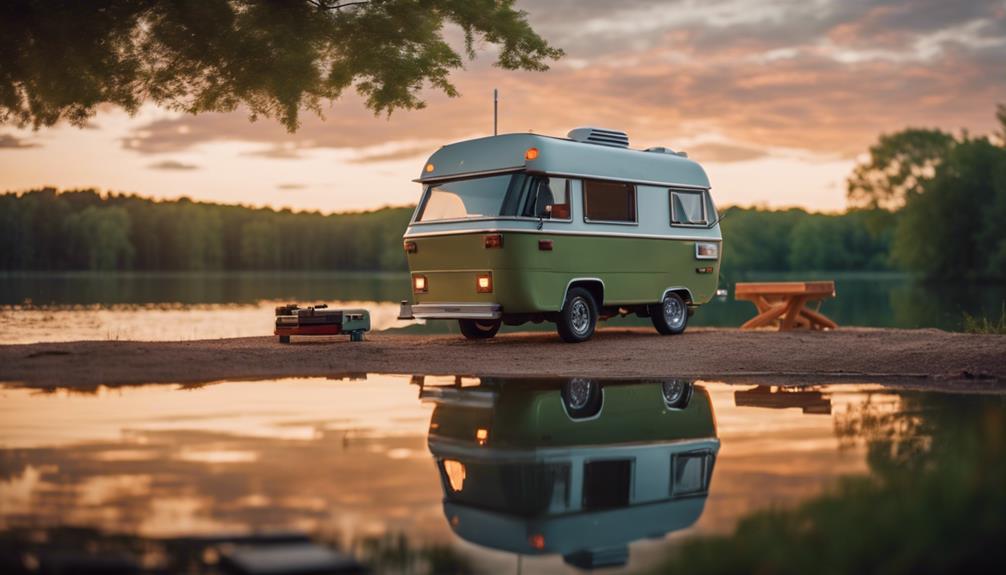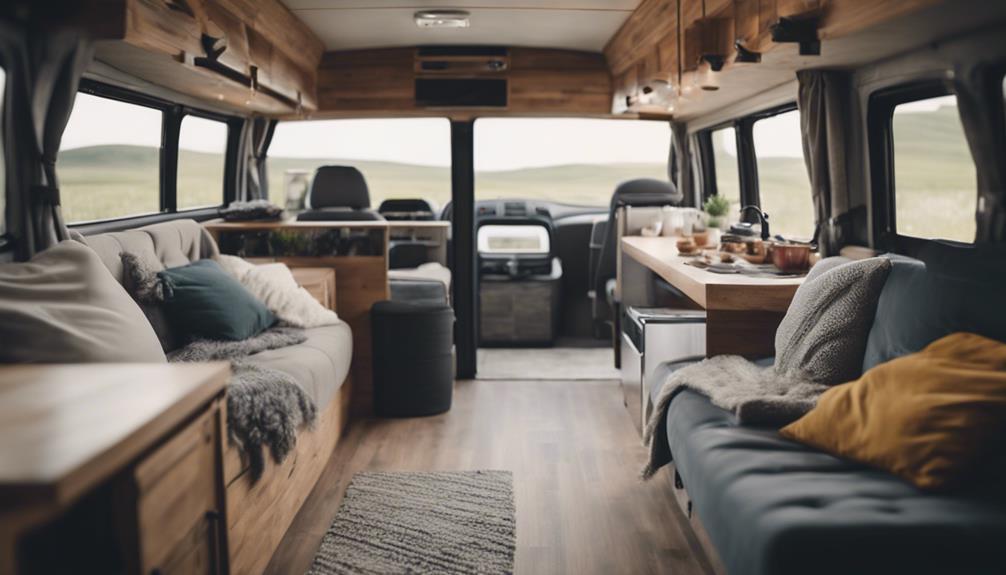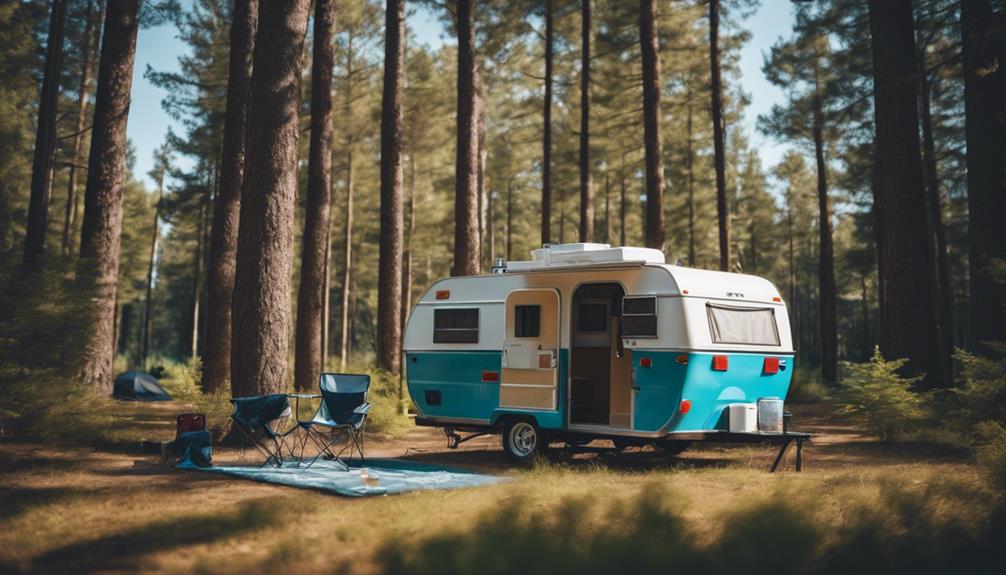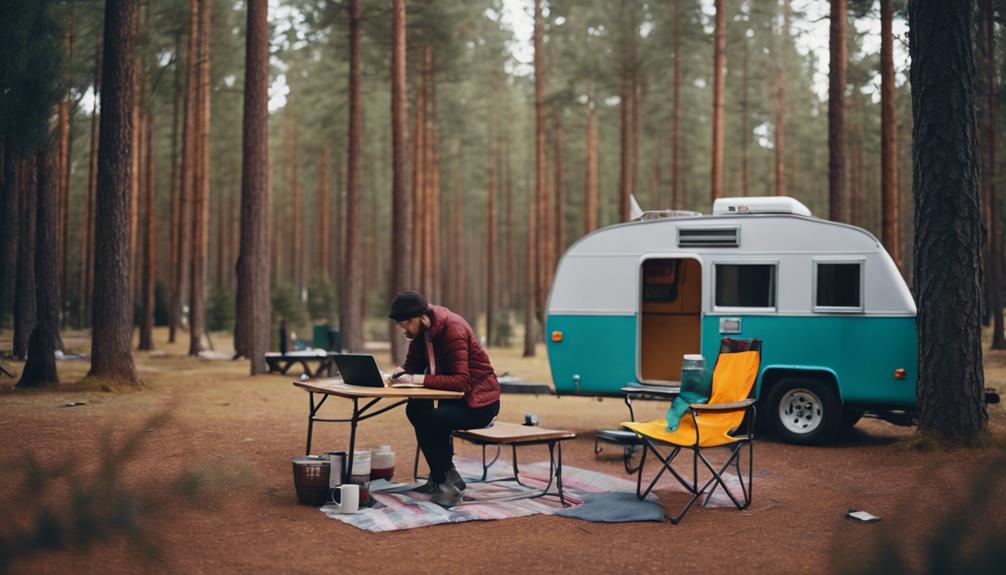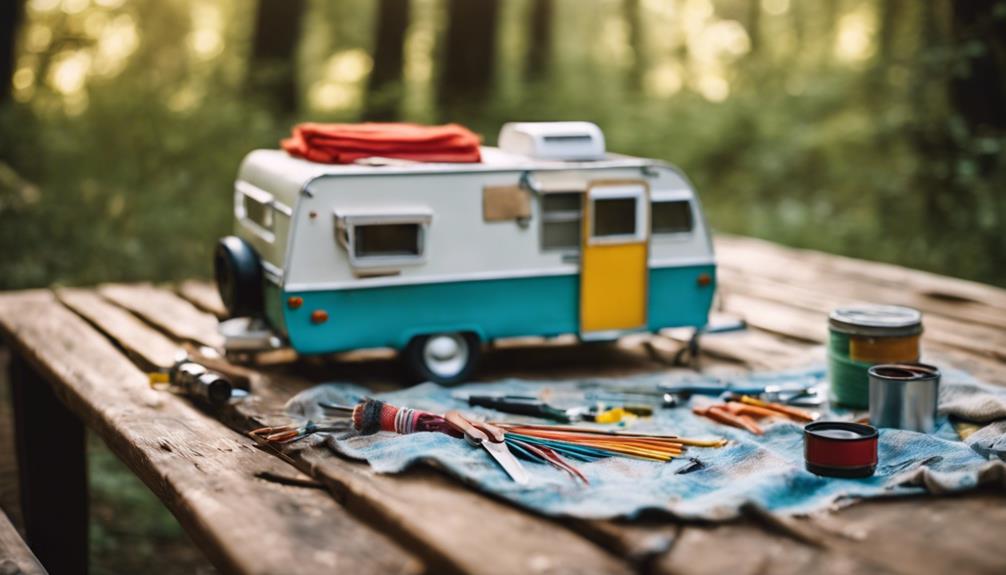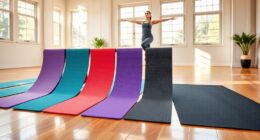Leveling your pop-up camper is essential for stability and comfort. Start by parking on a flat surface and use a bubble level to check your alignment. If needed, adjust the height using leveling blocks or a BAL Leveler. Once you're level, deploy stabilizer jacks at all corners to minimize movement. Don't forget to check for weight distribution, as an imbalance can complicate your setup. Regular inspections of your leveling equipment are important for safety. Looking for tips on tackling common challenges or enhancing your leveling process? There's plenty more to discover for a smoother camping experience. Consider investing in a leveling system with automatic or electronic controls for added convenience. Additionally, regularly maintaining and restoring your popup camper‘s leveling equipment can prolong its lifespan and ensure it functions properly. By staying on top of these tasks, you’ll be able to enjoy a more stable and comfortable camping experience for years to come.
Key Takeaways
- Start by parking on a flat surface and using a bubble level to check camper alignment before making adjustments.
- Use leveling blocks or a BAL Leveler on low sides to achieve the necessary height adjustments.
- Deploy stabilizer jacks at all corners after leveling to ensure even weight distribution and minimize movement.
- Regularly recheck the level, especially on soft or uneven ground, to maintain optimal stability during your stay.
Importance of Leveling a Pop-Up Camper
Leveling your pop-up camper is essential for ensuring your appliances work efficiently and for maximizing your comfort during your stay. When you don't properly level your camper, you risk malfunctioning appliances, especially your 3-way refrigerator. A level surface is vital for it to operate correctly.
Additionally, proper leveling enhances your overall comfort and prevents headaches and physical strain from sleeping on a slant.
Using stabilizer jacks helps to achieve a camper level that minimizes movement inside the trailer, reducing the likelihood of structural damage. If your camper isn't adequately leveled, you might face issues like misaligned doors and cabinets, which stress the frame and shorten its lifespan.
The extra effort you put into leveling your pop-up camper also pays off by reducing setup time.
Essential Tools for Leveling
To level your pop-up camper effectively, you'll need a few essential tools.
A BAL Leveler, stabilizer jacks, and bubble levels will help you achieve a stable setup on any terrain.
Let's explore how each of these tools contributes to a balanced camping experience.
Recommended Leveling Tools
Achieving a stable and balanced pop-up camper relies on a few essential leveling tools that can make the process quicker and more effective.
The BAL Leveler is a top choice for easily leveling single axle or pop-up trailers, guaranteeing stability with minimal effort. If you're dealing with uneven terrain, consider using Andersen Levelers for height adjustments, as they provide a smooth leveling experience.
To accurately assess your camper's level, don't overlook the Hopkins graduated levels. These tools offer clear indicators from multiple angles, allowing you to see when everything's aligned perfectly. A bubble level is also vital for checking both front-to-back and side-to-side balance, which helps prevent unnecessary structural stress.
For those seeking a thorough solution, Kohree Leveler Packs come in various sets to guarantee equal weight distribution across your camper. Additionally, leveling blocks can be handy for raising your camper to the desired height.
Using these tools together will greatly enhance your leveling efforts, providing a stable environment for your pop-up camper.
Usage of Stabilizer Jacks
Stabilizer jacks play an essential role in guaranteeing your pop-up camper remains steady and secure while you enjoy your outdoor adventures.
After you've leveled the trailer using blocks or ramps, deploy the stabilizer jacks at all four corners to help stabilize the camper. These jacks aren't designed to lift the trailer; instead, they minimize movement and shaking by distributing weight evenly across the camper's frame.
Before each trip, conduct a thorough inspection of jacks for wear and damage. This step is vital to confirm they can effectively support the camper's weight and maintain stability during use.
Alongside stabilizer jacks, using wheel chocks adds an extra layer of security, preventing both lateral and vertical movement.
Importance of Bubble Levels
Bubble levels are vital tools that help you guarantee your pop-up camper is perfectly leveled for a comfortable and efficient camping experience. These devices accurately assess both front-to-back and side-to-side leveling, ensuring your camper is positioned correctly. By incorporating bubble levels into your leveling system, you can easily make the necessary adjustments to maintain camper stability.
Using graduated bubble levels with adhesive strips provides easy visual feedback on your leveling status. This allows you to quickly determine if adjustments are needed. Many campers find that combining bubble levels with leveling blocks enhances their ability to achieve precise height adjustments on uneven terrain. This combination not only prevents issues like door misalignment and inefficient refrigerator operation but also greatly reduces setup time.
Regularly checking your camper's level during setup is essential. By ensuring you properly level your pop-up camper, you enhance its stability and make your camping experience much more enjoyable. So, don't underestimate the importance of bubble levels; they're key to achieving the perfect setup for your adventures.
Step-by-Step Leveling Techniques
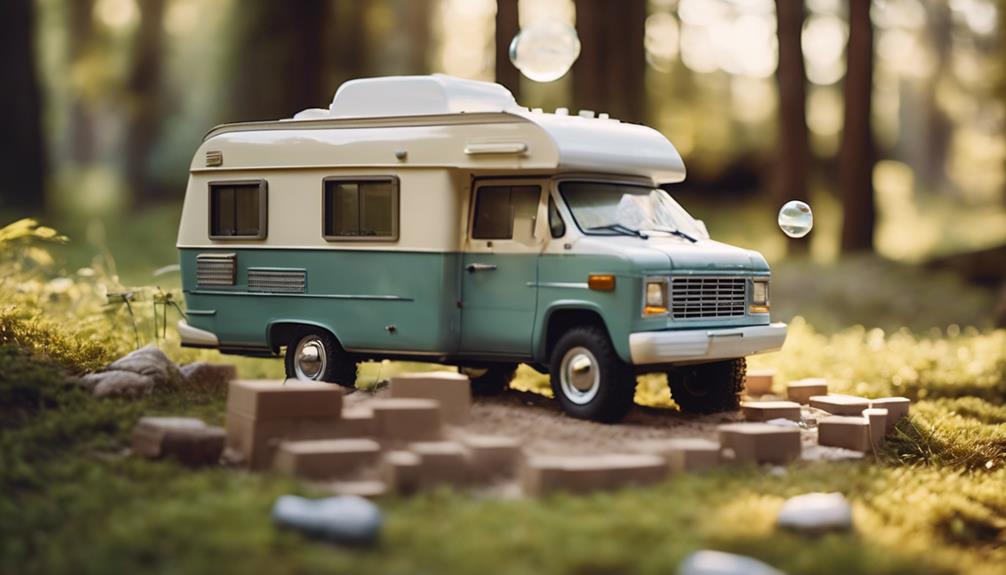
To level your pop-up camper effectively, you'll need a few essential tools and a clear process.
Start by evaluating the ground and preparing to make adjustments using leveling blocks or ramps.
With the right steps, you can guarantee your camper is stable and ready for a great camping experience.
Essential Leveling Tools
Having the right leveling tools is vital for setting up your pop-up camper safely and effectively. Start with leveling blocks to help raise your tires on uneven ground. These blocks provide a stable base, ensuring your travel trailer remains balanced.
A tongue jack is important for adjusting the height at the front of the camper, allowing you to align it with the trailer frame and achieve front-to-back leveling.
You'll also need a small level to check both side-to-side and front-to-back balance. Consider using a bubble level with adhesive strips for easy visibility, ensuring you can consistently monitor your camper's position.
For additional support, leveling jacks can help stabilize your pop-up camper once it's leveled, especially on soft surfaces.
If you're camping on unsteady ground, using wood blocks or leveling pads beneath your jacks can help distribute weight evenly and prevent sinking.
Finally, always refer to your camper's owner's manual for specific instructions on the tools you'll need and any unique requirements for effective leveling.
With these essential tools in hand, you're well on your way to setting up a stable and comfortable camping experience.
Leveling Process Steps
With your leveling tools ready, you can start the leveling process by parking your pop-up camper on a flat surface, if possible, and checking its level using a bubble level placed at multiple points. Assess both the front-to-back and side-to-side levels.
If your camper isn't level, grab your leveling blocks or a BAL Leveler. Place these blocks under the wheels on the low side to raise the camper until it's level.
Once you've adjusted the camper, use the tongue jack to fine-tune the front-to-back leveling. Recheck the level with your bubble level to verify accuracy. When the camper is level on all sides, extend the stabilizer jacks to minimize movement and stabilize the camper further.
Don't forget to lower the stabilizer jacks only after confirming the camper is level. After setting up, especially on soft or uneven ground, it's wise to regularly check the level again. Small adjustments may be necessary for ideal stability and safety, particularly with a single axle trailer.
Following these steps will guarantee your pop-up camper is safe and stable for your camping adventure.
Common Leveling Challenges
Common leveling challenges often arise from uneven ground surfaces, which can compromise your camper's stability. When you park on soft or sloped areas, your camper might sink or tip, leading to potential safety hazards. Inadequate stabilization can result in noticeable shaking or movement inside, especially when you shift positions or if it's windy outside.
Another common issue is improper use of stabilizers. Remember, stabilizers are designed for support, not leveling. If you rely on them for leveling, you'll likely experience swaying, which can be uncomfortable.
Additionally, weight imbalance caused by uneven loading or improper distribution of gear can further complicate stability, increasing the risk of tipping.
You should also be aware that problems with lift cables can arise from incorrect deployment or adjustments. These issues can make it difficult to raise or lower your camper's roof properly, impacting overall functionality.
To guarantee a stable camping experience, pay attention to these common leveling challenges and address them before setting up your pop-up camper. Proper planning and execution can make all the difference in keeping your setup safe and comfortable.
Maintenance of Leveling Equipment
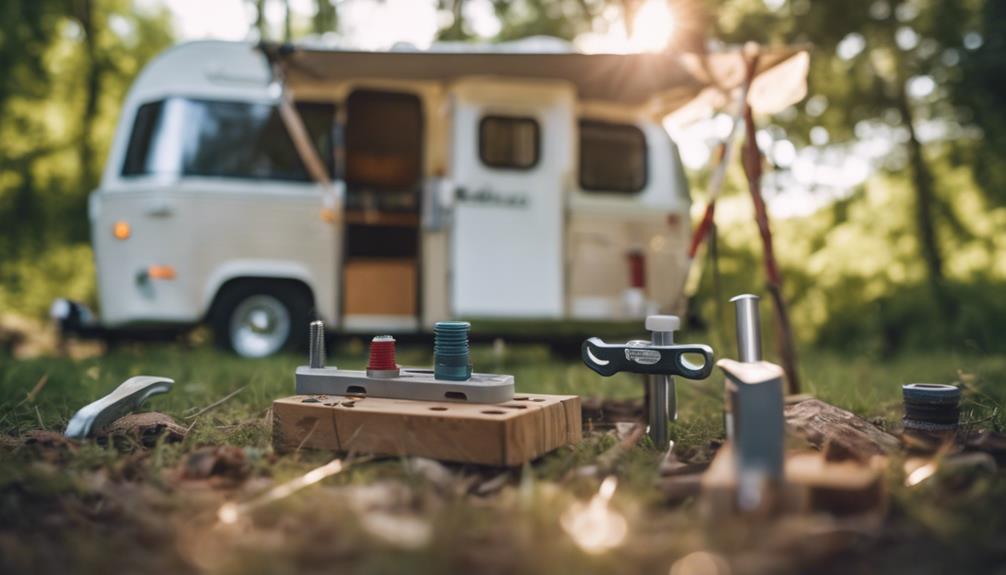
To guarantee your pop-up camper remains stable and safe, it's important to regularly maintain your leveling equipment. Start by inspecting your stabilizer jacks and leveling blocks for any signs of wear and tear. If you notice any damage, replace them immediately to guarantee effective functioning.
Cleaning and lubricating moving parts is essential to prevent rust and guarantee smooth operation. This simple maintenance task can considerably extend the lifespan of your equipment. Store your leveling tools in a dry, accessible location to avoid damage and make setup easier.
Don't forget to check the adhesive strips on your bubble levels. Replace them periodically to maintain accurate readings, as worn strips can lead to improper leveling.
Following the maintenance guidelines in your owner's manual is vital. These documents often outline specific check intervals for each piece of equipment to guarantee peak performance.
Community Tips and Resources
Engaging in community forums like PopUpPortal can offer you valuable insights and practical tips from experienced campers on leveling your pop-up camper effectively. These community discussions can provide you with the knowledge you need to know about various leveling techniques and tools.
Here are some key resources to contemplate:
- Instructional videos: Check out video tutorials that guide you through the process of leveling your trailer.
- Recommended tools: Many users highly recommend quality leveling tools like the BAL Leveler or Andersen Levelers for better stability.
- DIY solutions: Discover creative homemade stabilizers made from laminated oak that can save you money while providing solid support.
Frequently Asked Questions
How to Make a Pop-Up Camper More Stable?
To make your pop-up camper more stable, use wheel chocks on both sides, deploy stabilizer jacks after raising the roof, and consider leveling pads to distribute weight evenly. Regularly inspect all equipment for safety.
How to Properly Level a Pop-Up Camper?
Leveling a pop-up camper's like balancing a tightrope; find a flat spot first. Use leveling blocks under tires if needed, check with a bubble level, and deploy stabilizer jacks to minimize movement inside.
Does a Pop-Up Camper Have to Be Perfectly Level?
A pop-up camper doesn't have to be perfectly level, but it should be close. Minor deviations are fine, but significant ones can lead to issues with appliances and overall comfort during your camping experience.
How Do You Stabilize and Level a Camper?
To stabilize and level your camper, use leveling blocks or a BAL Leveler to adjust the tires. Deploy stabilizer jacks afterward, and don't forget to add wheel chocks for extra safety and stability.
What’s the Importance of Leveling a Pop-Up Camper for Stability and Comfort?
When it comes to balancing a popup camper, stability and comfort are key factors. Leveling the camper ensures that it’s safe to use and provides a comfortable environment for living and sleeping. It also helps to prevent any potential damage to the camper and creates a better camping experience overall.
Can Battery Power Affect the Stability of a Pop-Up Camper?
When considering tips for running popup camper off battery, it’s important to note that battery power can indeed affect the stability of a pop-up camper. Insufficient battery power can lead to issues with the camper’s stabilizing mechanisms, impacting the overall stability and levelness of the unit. Regularly checking and maintaining the battery is crucial for a smooth camping experience.
Conclusion
Leveling your pop-up camper isn't just about comfort; it's about safety. A stable setup prevents spills and keeps your belongings in place, while an unlevel camper can lead to frustration and mishaps.
With the right tools and techniques, you can transform a lopsided experience into a smooth getaway. So, don't underestimate the power of proper leveling—your adventures deserve a solid foundation, and a well-leveled camper can turn a good trip into a great one.

